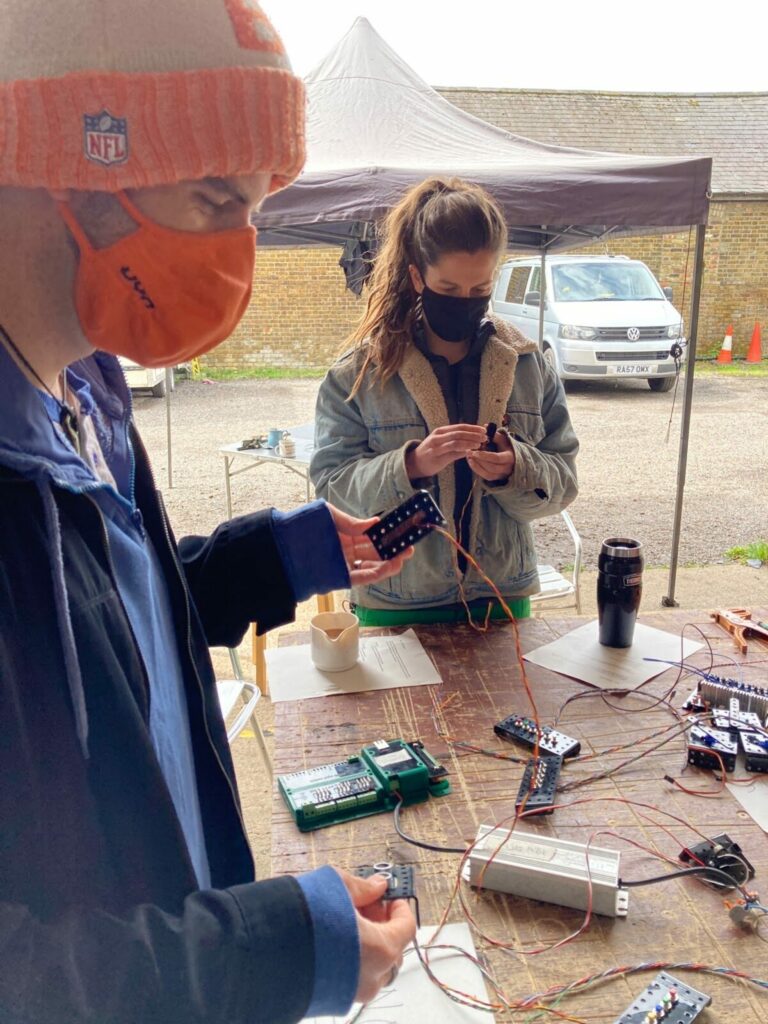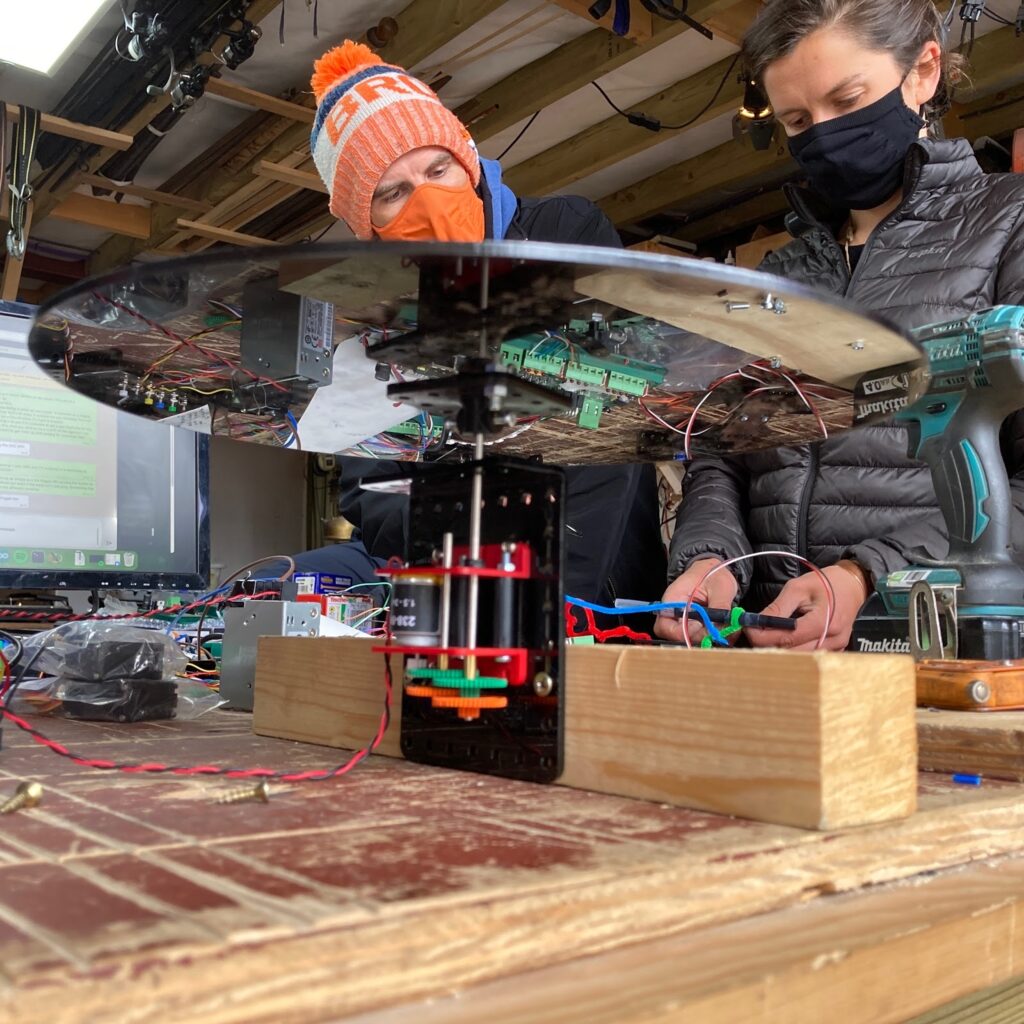Bailes + Light social media guru Alexis H. Truax reports on our first attempt at OSCHII labs.
Bailes + Light has been hard at work creating interactive technology that allows people from all walks of life to realise their imagination. But what magic might flow when a group of artists and creatives are set free with OSCHII to experiment and play?
Over a stormy weekend in May, a group of creatives and artists came together at the Bailes + Light studios on the beautiful Aldborough Hall Farm in Ilford, London.
We were a diverse lot: artists, educators, makers, writers, and even a magician! The peacocks in the courtyard paced and screeched as the sky heaved between bright sunshine and torrential downpour. In the studio, our little group sat in hushed anticipation.
As the sun peeked out from behind threatening clouds and the friendly farm cat weaved between our legs, Eva, our fearless facilitator (and Bailes + Light creative project lead), began to explain our mission.
OSCHII is able to read inputs: movement toward a sensor, a finger on a button, a sound, or a Tweet – and turn it into an output – switching on a light, turning a motor, playing back a recording or flashing a request for a cup of tea across a monitor.
Could we learn how OSCHII bridges the physical and digital worlds and use our new found knowledge to make games that cross realities?

This weekend we would learn how to use OSCHII, we would play with some of its many features and we would work together to create interactive games that could support children’s artistic talent and creativity. This would inform our own creative work, let us explore what is possible with OSCHII technology and help steer OSCHII’s continued development.
As we began our first task, the work stations were littered with curious bits of tech: motion sensors and tranceiveres, toggle switches and gears.
So what could we do with this kit? Would the ink kill the OSCHII box, would the sand jam the motors, would a ball bearing fly off and take someone’s eye out? Read on to find out….
It was time to get a hands-on feel for the technology and everyone had a slightly different approach. One group went for fun and functional, using a beam breaker to play a recording reminding everyone to mask up as they entered the threshold of the workshop. Another designed a light that would shine brighter the closer a person moved toward it. Yet another took a games approach to the task by programming a series of colored buttons that, when pushed in combination, would illuminate LEDs: red and yellow for orange light, green and yellow for blue.
Confident in our basic understanding of the technology’s capabilities we dived into game-making.

Eva had given us a mysterious and intriguing instruction for the weekend: bring 3 fun objects. As we each brought out our stash, the table was stacked high with an assortment of random and playful objects: pipe cleaners and sand, ink and kaleidoscopes, toothpaste and noisemakers of several varieties.
Looking at our table of supplies, both groups quickly decided that the most promising objects were traditional art supplies and musical instruments. We could combine them with digital and mechanical devices in new and unforeseen ways: Melding traditional tools of creativity with new technology to create surprising forms of expression & novel experiences.
Team Octopus decided to build a game that would allow participants to create art collaboratively. It would use traditional art supplies like ink & charcoal but require players to work together to figure out how to use sensors and buttons to move them across the page.
Team Cicada would design a treasure hunt that would let participants explore their surroundings to reveal answers that would play a tune and illuminate a series of coloured lights.
We got to work. The studio was abuzz with drilling and sawing, the whirring of motors, the plinking of a xylophone and excited chatter. With a whole workshop of materials and the incredible skill and knowledge of the B+L team, our games slowly came together. By the end of the day we were ready to share our new creations.
The studio was abuzz with drilling and sawing, the whirring of motors, the plinking of a xylophone and excited chatter.
The treasure hunt began with participants scanning a code to receive a map on their phones. By following the map and a series of clues we wandered all over the farm to find tiny mallets hidden around the property. When we placed the mallets correctly into a tube, it would spin to play a recognisable tune on the xylophone. Contact sensors under the keys set off a series of colored lights in a specific order.
The collaborative drawing game had three players at different stations who had to work together to create a piece of art through sound and movement. One player controlled the rotation of the paper by moving his hand closer and farther away from a proximity sensor. Another controlled the movement of the pen with the volume of her voice. The third controlled the movement of the pencil by pressing a series of buttons. The catch? Each player’s station could only be activated by a player across the table. There was much amusing waving of hands, singing and pressing of buttons as the players learned how to work together to guide the pen and pencil across the page. The results were impressive and now adorn the studio fridge!
The OSCHII creative lab with Bailes + Light was a joyful weekend of creative learning through play and experimentation. We combined traditional and technological forms of expression to create games that opened up new ideas for collaboration and discovery.
Want to get involved? Bailes + Light hope to open the lab up to more participants later this summer. Contact us to register your interest.



